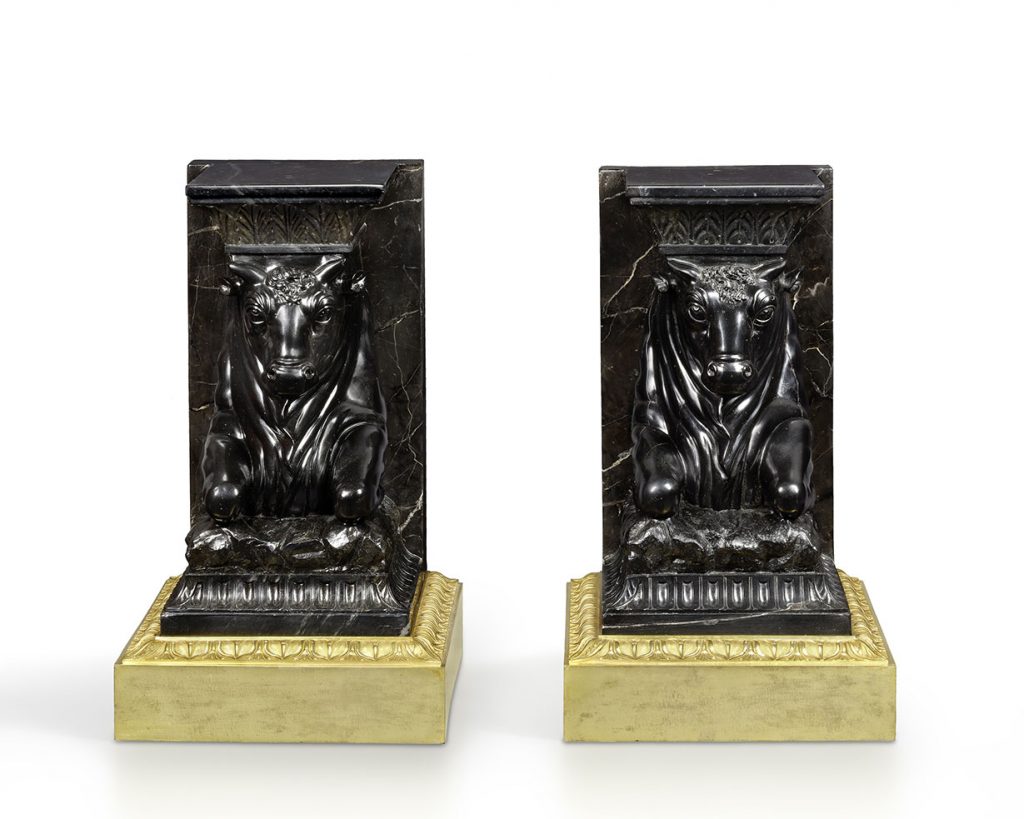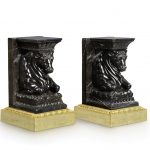A pair of black marble bull pedestals

A pair of Empire gilt bronze-mounted black grand antique
and portor marble pedestals formed as bulls’ forequarters
circa 1805-1810
The marble bulls Roman, possibly by Lorenzo Cardelli, late 18th – early 19th Century
Lorenzo Cardelli (1733-1794)
Height: 35 cm. (13 ¾ in.) Width: 21 cm. (8 ¼ in.) Depth: 23.7 cm. (9 ¼ in.)
Originally these pedestals were candelabra bases which supported kneeling Egyptian female figures with outstretched arms holding aloft the candle-arms. A pair of identical candelabra were in the collection of the Ney family, hereditary Princes of Moscow and Ducs d’Elchingen, sold Galerie Georges Petit, Paris, 27 May 1929, lot 58.
Provenance
Galerie Steinitz, Paris
Comparative Literature
G.A. Visconti and E.Q. Visconti, Il Museo Pio-Clementino, tom. VII, Miscellanea del Museo Pio-Clementino, Rome, 1807, p. 58 and tav. XXXIV.
A.González-Palacios, Il Gusto dei principi: arte di corte del XVII e del XVIII secolo, Milan, 1993, vol. II, pp. 268-269, fig. 536.
A.González-Palacios, Il serraglio di pietra: La sala degli animali in Vaticano, Vatican City, 2013, pp. 116-117 and p. 228, no. 72.
A.González-Palacios, Luigi Valadier, New York, 2018, pp. 182-198, esp. p. 193 and p. 198, fig. 4_73, and p. 519.
A.Bignamini and C. Hornsby, Digging and dealing in eighteenth-century Rome, New Haven and London, 2010, p. 90, no. 163.
Two types of marble have been used here. The bulls and the architectural elements they rest on and support are of a hard Italian black marble capable of being highly polished although very hard to carve. They have then later been backed with strips of portor marble, most likely in France when the gilt bronze bases were added.
These beasts are closely modelled on the ancient white marble bull in the Vatican Museums (González-Palacios 2013, op. cit., no. 72; fig. 1). This itself may have been a distant echo of the bull’s head capitals employed at the Hall of the Hundred Columns of Persepolis in the 5th Century BCE. The Vatican bull was sold to the Museum by the son of the great engraver-restorer Giambattista Piranesi and was dedicated to Pope Pius VI in 1779. The first printed image of it came in 1807 as part of Visconti’s multi-part illustrated catalogue of the Vatican Museums (fig. 2), although clearly the Roman artistic milieu was aware of its precise shape much earlier, either through circulation of Piranesi’s drawings, or by studying the actual artefact in person at the Museum’s Sala degli animali (where it remains to this day).
Reductions of this famous marble were produced by prominent Roman artists in the circle of the silversmith Luigi Valadier:
- A white marble tazza mounted in gilt bronze and supported by three such bulls also in gilt bronze was published from a private collection by González-Palacios in 2018 ( cit., fig. 4_73; fig. 3). It is identifiable in the inventory of the Braschi Deser, originally created by Valadier in Rome in 1783, which was later compiled in 1801 when the surtout was at the Musée Napoleon in Paris (today’s Louvre) (ibid., p. 193)
- A coloured marble centrepiece from another unspecified Deser featuring three more bulls by Valadier’s pupil Francesco Righetti is in the Museo di Capodimonte in Naples (González-Palacios 1993, cit., fig. 536; fig. 4). It comprises comprising a tazza supported by atlantes resting on a triangular base with the bulls – this time in patinated bronze – supporting each corner.
These black marble versions of the bull show that the ancient archetype was also reduced by a talented Roman stone carver. The outstanding candidate is Lorenzo Cardelli (1733-1794), the leading decorative sculptor of his day, who worked extensively for Marcantonio Borghese at his villa in the late 1770s and early 1780s, creating the carved elements for a series of chimney pieces many of which remain in situ. Cardelli is also known to have worked for Valadier on the Baron de Breteuil Deser (Diario Ordinario, 20 June 1778, no. 362, cited by González-Palacios 2018, op. cit., p. 519) and so is very likely to have been involved a few years later in the Braschi Deser, with its far greater number of figural elements which as shown definitely featured gilt bronze reductions of the Vatican bull.
Cardelli founded a celebrated marble workshop in the Via Condotti, and also excavated antique marbles in and around Rome, several of which he, like Piranesi, offered to the Pope’s museum projects. He was praised by luminaries such as the English dealer, Thomas Jenkins for his ability to work hard veined black marble (Bignamini and Hornsby, op. cit., no. 163.). Canova visited his studio in 1779 and favourably commented on his fireplaces, porphyry and hardstone work and noted three reduced copies of ancient statues.[1]
[1] A. Canova, Quaderni di viaggio, E. Bassi (ed.), Florence, 1959, p. 37.


